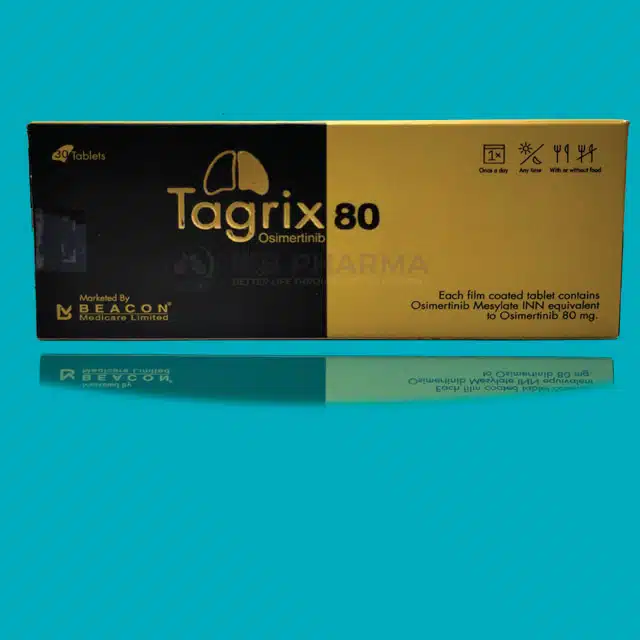Post by iebpharma on Jun 20, 2024 8:01:49 GMT -5
Tagrix (Osimertinib) 80 mg is a medication used primarily in the treatment of non-small cell lung cancer (NSCLC). Osimertinib, the active ingredient in Tagrix, is a third-generation epidermal growth factor receptor (EGFR) tyrosine kinase inhibitor (TKI). This class of drugs is designed to target and inhibit the EGFR, a protein that plays a crucial role in the growth and spread of cancer cells. The development and clinical use of Osimertinib have significantly advanced the treatment landscape for patients with EGFR mutation-positive NSCLC.
Mechanism of Action
Osimertinib selectively targets both EGFR mutations and T790M resistance mutations. The T790M mutation is a common cause of resistance to first- and second-generation EGFR TKIs, making Osimertinib a crucial option for patients who have Tagrix 80 Mg ( OSIMERTINIB) developed resistance to earlier treatments. By binding irreversibly to the mutated forms of EGFR, Osimertinib inhibits the signaling pathways that promote cancer cell proliferation and survival, leading to reduced tumor growth and potentially improving patient outcomes.

Indications
Tagrix is indicated for the first-line treatment of patients with metastatic NSCLC whose tumors have EGFR exon 19 deletions or exon 21 (L858R) substitution mutations. It is also indicated for patients with metastatic EGFR T790M mutation-positive NSCLC, as detected by an FDA-approved test, who have progressed on or after EGFR TKI therapy.
Dosage and Administration
The recommended dosage of Tagrix is 80 mg taken orally once daily, with or without food. The tablets should be swallowed whole with water and should not be crushed, split, or chewed. Consistency in taking the medication at the same time each day helps maintain an appropriate level of the drug in the bloodstream.
Clinical Efficacy
Clinical trials have demonstrated the efficacy of Osimertinib in improving progression-free survival (PFS) and overall survival (OS) in patients with EGFR mutation-positive NSCLC. In the FLAURA trial, Osimertinib significantly extended PFS compared to first-generation EGFR TKIs like erlotinib and gefitinib. Patients treated with Osimertinib also experienced a better safety profile, with fewer severe side effects, making it a preferred option for first-line therapy.
Side Effects
Common side effects of Tagrix include diarrhea, rash, dry skin, and nail toxicity. More serious but less common side effects can include interstitial lung disease (ILD), QT interval prolongation, and cardiomyopathy. Monitoring for these side effects is essential, and patients should report any new or worsening symptoms to their healthcare provider promptly.
Mechanism of Action
Osimertinib selectively targets both EGFR mutations and T790M resistance mutations. The T790M mutation is a common cause of resistance to first- and second-generation EGFR TKIs, making Osimertinib a crucial option for patients who have Tagrix 80 Mg ( OSIMERTINIB) developed resistance to earlier treatments. By binding irreversibly to the mutated forms of EGFR, Osimertinib inhibits the signaling pathways that promote cancer cell proliferation and survival, leading to reduced tumor growth and potentially improving patient outcomes.

Indications
Tagrix is indicated for the first-line treatment of patients with metastatic NSCLC whose tumors have EGFR exon 19 deletions or exon 21 (L858R) substitution mutations. It is also indicated for patients with metastatic EGFR T790M mutation-positive NSCLC, as detected by an FDA-approved test, who have progressed on or after EGFR TKI therapy.
Dosage and Administration
The recommended dosage of Tagrix is 80 mg taken orally once daily, with or without food. The tablets should be swallowed whole with water and should not be crushed, split, or chewed. Consistency in taking the medication at the same time each day helps maintain an appropriate level of the drug in the bloodstream.
Clinical Efficacy
Clinical trials have demonstrated the efficacy of Osimertinib in improving progression-free survival (PFS) and overall survival (OS) in patients with EGFR mutation-positive NSCLC. In the FLAURA trial, Osimertinib significantly extended PFS compared to first-generation EGFR TKIs like erlotinib and gefitinib. Patients treated with Osimertinib also experienced a better safety profile, with fewer severe side effects, making it a preferred option for first-line therapy.
Side Effects
Common side effects of Tagrix include diarrhea, rash, dry skin, and nail toxicity. More serious but less common side effects can include interstitial lung disease (ILD), QT interval prolongation, and cardiomyopathy. Monitoring for these side effects is essential, and patients should report any new or worsening symptoms to their healthcare provider promptly.
